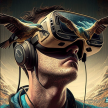AI-Generated Art and Its Impact on Creativity
A Glimpse into the Future of Artistic Expression

Introduction
In recent years, the world has witnessed an explosion of artificial intelligence (AI) in various fields, revolutionizing industries and redefining human experiences. One such domain that AI is making significant strides in is the realm of art. AI-generated art is an innovative fusion of human creativity and machine learning, leading to stunning masterpieces that challenge traditional notions of artistic expression. In this blog, we will delve into the mesmerizing world of AI-generated art, exploring its implications for artists, art enthusiasts, and the future of creativity.
1. The Emergence of AI in Art
Artificial Intelligence has rapidly advanced in its ability to analyze, learn, and replicate human-like patterns. From natural language processing to image recognition, AI algorithms can now create visual art pieces that mimic human artists' styles and techniques. Through a combination of deep learning, neural networks, and generative algorithms, AI can produce unique artworks that evoke emotion and intrigue.
2. Implications for Artists
Many artists view AI-generated art as a double-edged sword. On one hand, it can be a valuable tool for enhancing creativity and pushing artistic boundaries. AI algorithms can assist artists by generating abstract concepts, suggesting color palettes, or even providing inspiration for new projects. This symbiotic relationship between artists and AI encourages experimentation and opens up new possibilities.
On the other hand, some artists fear that AI-generated art could devalue the human touch and diminish the role of the creator. There are concerns that the increasing prevalence of AI-generated art might flood the market, making it challenging for human artists to compete or gain recognition for their work.
However, the debate over the impact of AI on the traditional art community also sparks conversations about the nature of art itself. Some argue that AI-generated art reflects the essence of human creativity by showcasing the intelligence behind the machine. As AI advances, the distinction between man and machine becomes blurred, raising questions about the very definition of creativity.
3. Enriching Art Enthusiasts' Experience
For art enthusiasts, AI-generated art provides a gateway to explore novel and innovative visual experiences. AI algorithms can analyze an individual's preferences and create personalized art pieces tailored to their tastes. This interactive element enhances audience engagement, fostering a deeper connection between art and observer.
AI also bridges the gap between artists and their audiences. As AI-generated art becomes more accessible and widely shared, it can introduce people to art forms they might not have encountered otherwise. This democratization of art can inspire more people to appreciate and participate in the creative process.
4. Ethical Considerations
Despite the fascinating advancements, AI-generated art raises ethical concerns, particularly regarding authorship and intellectual property. Determining ownership and copyright of AI-generated artworks can be complex, as they are products of both human input and machine algorithms. The lack of clarity in legal frameworks may result in disputes and challenges in the art industry.
Furthermore, as AI algorithms learn from vast datasets, they may inadvertently replicate biased or controversial themes found in the training data. This raises questions about the responsibility of artists and developers to ensure that AI-generated art does not perpetuate harmful stereotypes or messages.
5. The Future of Creativity
AI-generated art is only the beginning of AI's impact on creativity. As technology continues to evolve, AI has the potential to revolutionize the way art is created, consumed, and appreciated. Artists may collaborate directly with AI systems, blurring the line between human and machine collaboration in the artistic process.
Moreover, AI could foster interdisciplinary creativity, combining art with other fields such as music, literature, and architecture. This fusion of disciplines may give rise to entirely new art forms that push the boundaries of human imagination.
Conclusion
AI-generated art presents a paradigm shift in the world of creativity, offering artists new tools and art enthusiasts novel experiences. While the rise of AI-generated art sparks debates and challenges, it also paves the way for unprecedented opportunities in the ever-evolving landscape of artistic expression. As we venture further into the world of AI-generated art, we must embrace this technological marvel while being mindful of its ethical implications, ensuring that creativity remains a beautiful and diverse reflection of the human spirit.
About the Creator
James butler
"Captivating your audience one word at a time. Lover of all things creative. Find me in a coffee shop or lost in a good book."






Comments
There are no comments for this story
Be the first to respond and start the conversation.